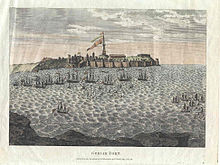HMS Tiger (1747)
 Tiger
| |
| History | |
|---|---|
| Name | HMS Tiger |
| Ordered | 17 March 1746 |
| Builder | Stanton and Wells, Rotherhithe |
| Laid down | April 1746 |
| Launched | 23 November 1747 |
| Commissioned | December 1747 |
| In service |
|
| Honours and awards | |
| Fate | Sold out of service, Bombay, 12 May 1765 |
| General characteristics | |
| Class and type | 1745 Establishment 60-gun fourth rate ship of the line |
| Tons burthen | 1,21815⁄94 bm |
| Length |
|
| Beam | 43 ft 1 in (13.1 m) |
| Depth of hold | 18 ft 6 in (5.6 m) |
| Sail plan | Full-rigged ship |
| Complement | 420 |
| Armament |
|
HMS Tiger or Tygre was a 60-gun fourth rate ship of the line of the Royal Navy, built at Rotherhithe to the draught specified by the 1745 Establishment and launched on 23 November 1747.[1]
[]
Tiger was commissioned in December 1747 under Captain Charles Saunders, as a reinforcement for the British fleet then in action against France in the War of the Austrian Succession. She was assigned to a squadron under the overall command of Admiral Peter Warren, but saw no active engagement in her first months at sea. The war ended with the signing of the Treaty of Aix-la-Chapelle in April 1748, and Tiger was returned to Deptford for service as a guard ship. Charles Steevens replaced Saunders as Tiger's captain in 1749, but the vessel remained at Deptford until she was decommissioned in November 1752.[2]
Two months later, in January 1753, Tiger was restored to her duties as a guard ship but relocated to Portsmouth Dockyard. Command was transferred to Captain Samuel Marshall, and then to Captain Thomas Latham in early 1754. In early 1754 the vessel was assigned to the protection of British merchant interests in the East Indies.[2]

In the British anti-piracy campaign of 1756 HMS Kent, , and Tiger carried 300 Indo-Portuguese Topazes to capture the fortress of Gheriah on 14 February 1756.[3]

In 1756 war broke out between France and Great Britain, and Colonel Robert Clive of the British East India Company and Admiral Charles Watson of the British Navy bombarded and captured Chandannagar on 23 March 1757.[4] In order to take the Fort d'Orleans guarding the town, Tiger and Kent managed to edge up the Hooghly river, although the French had tried to block it with sunken ships, booms and chains.[4] When they were close to the fort, they opened fire with all guns, but took a great punishment from the French in the process.
Fate[]
Tiger was converted to serve as a hulk in 1760, and in 1765 she was sold out of the Navy.[1]
Notes[]
References[]
- Lavery, Brian (2003) The Ship of the Line - Volume 1: The development of the battlefleet 1650-1850. Conway Maritime Press. ISBN 0-85177-252-8.
- Winfield, Rif (2007). British Warships of the Age of Sail 1714–1792: Design, Construction, Careers and Fates. Seaforth. ISBN 9781844157006.
- Ships of the line of the Royal Navy
- 1747 ships
- United Kingdom ship of the line stubs